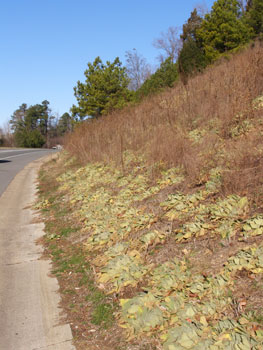Roadside carpet of mullein
By Ken Moore
Flora columnist
Flora’s focus this week is wooly mullein, Verbascum thapsus, also called velvet-leaf, flannel-leaf, Jacob’s staff and Quaker rouge. It’s in abandoned fields, on roadsides and even in pavement openings, single or clustered in patches.
Last week a Citizen reader urged me to describe the extensive carpet of mullein on that sloping, south-facing roadside adjacent to the on-ramp from Columbia Street to the N.C. 54 Bypass going west toward Carrboro. I’ve been enjoying that growing roadside population of mullein for years, and this year hundreds of mullein rosettes are effectively carpeting the hillside. It’s also notable that interspersed within that shaggy carpet of mullein are numerous fire-ant hills, definitely to be avoided.
Generally described as a biennial, mullein grows one year, then flowers, produces seed and dies the second year. Studies have determined that some plants will germinate, grow, flower, produce seed and die in one year, and other plants may continue this short lifecycle into a third year or more. That’s quite a survival strategy.
What may seem limiting is it requires open ground to survive, so you won’t find it in forests or competing with vigorous perennials. However, its seed remains viable for up to 100 years, so it is ready to take advantage of disturbance on any site – another good survival strategy.
We have the Quakers to thank for one of the humorous common names. Not allowed to use makeup, these settlers rubbed wooly mullein leaves on the face for a long-lasting ruby blush. Quaker rouge was an effective makeup without breaking Quaker rules.
Native Americans quickly learned about the utility of this plant immigrant. Medicinal and utilitarian descriptions are endless. The Lumbee stuffed the flannel-like leaves in their moccasins for warmth in cold months. Tall dried flower stems (Jacob’s staff) served as torches. The hardness of the dried stems made it a preferred stem for fire-making hand-drills.
Fresh and dried mullein leaves and the yellow flowers have been used effectively as inhalants, teas, infusions, poultices and salves for countless injuries and ailments.
Engaging descriptions of traditional uses of Mullein are offered by Tom Brown Jr., the guru of outdoor survival training, in Tom Brown’s Field Guide: Wild Edible and Medicinal Plants. I love his description of yellow-flowering stems standing tall in green summer fields “ … that looked like people standing erect, worshiping the Creator.â€
In moderation, mullein is an engaging garden plant. I vividly remember a visit to that grand garden at Chatsworth, home of the Duchess of Devonshire in central England. To my inquiry about the mulleins growing haphazardly along pathways, the gardener responded: “Oh, that’s mullein, a favorite of the Duchess and we’re instructed not to weed a one of them!â€
In my yard I take care to nurture a few wooly mullein rosettes to enjoy throughout cold months, anticipating their tall yellow-flowered stems in mid-summer.
Email Ken Moore at flora@carrborocitizen.com. Find previous Ken Moore Citizen columns at The Annotated Flora.




Comments are closed.